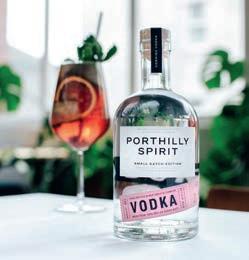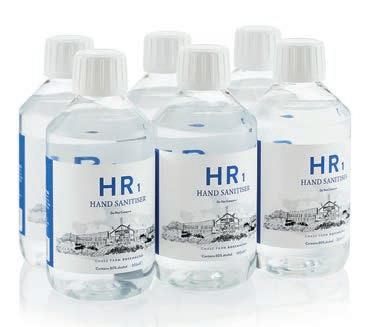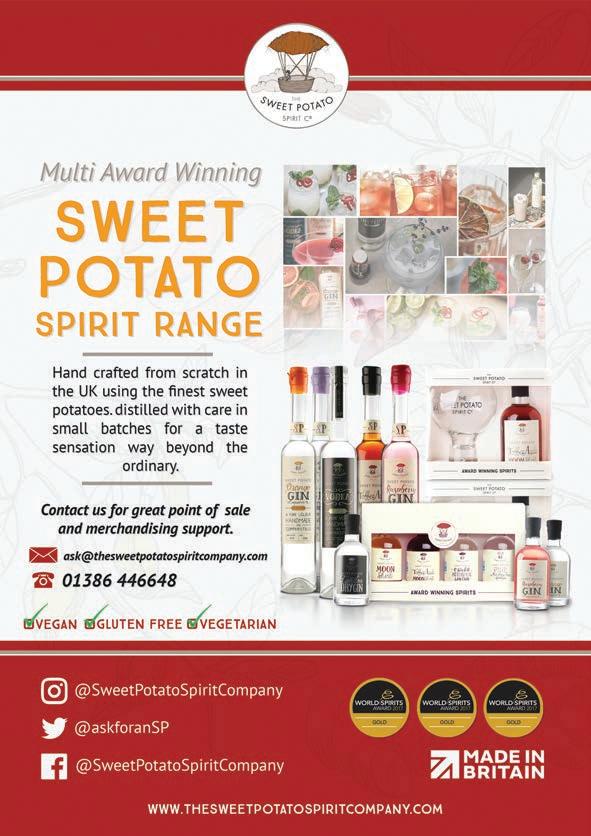
8 minute read
INSIDE
Shaken then stirred
While COVID-19 and its lockdown has proved challenging – especially as the on-trade disappeared for several months – small-batch distilleries have managed to keep supplying avid consumers via online and independent retail channels. CHRIS MERCER nds out how the spirits sector is surviving and identies a few new trends on the way.
BRITAIN’S NEW GENERATION of smallbatch distillers and drinks makers have shown resourcefulness in the face of the coronavirus pandemic, oering hope for the sector and for independent retailers.
Learning new skills in lockdown has been a necessity for producers and shop owners alike, from website design and online Zoom tastings to the altogether dierent task of making hand sanitiser.
Yet, while many have shown a willingness to switch focus and nd new ways of working, the immediate economic fallout of the COVID-19 public health emergency still proved severe.
Who could have guessed at the turn of 2020 that food and drink sales in cafés, restaurants and bars would fall by 60% in March versus the same month of 2019? That’s exactly what the analysis by research consultancy the CGA group showed.
“Overnight the on-trade became nonexistent,” says James Oag-Cooper, MD of Foxhole Spirits, known for making premium gin by using surplus wine grapes. The company had planned a big on-trade spend this year.
During lockdown, several retailers reported drinks sales normally only seen at Christmas, especially for wine, but there were also reports of consumers trading down to cheaper spirits brands.
In other parts of the ‘cra’ drinks sector, the Society of Independent Brewers (SIBA) said in April that nearly two thirds of breweries had stopped production.
Amid such ongoing uncertainty, what can we say about the condition of smallbatch spirits and drinks makers? And how should independent retailers think about the situation?
According to some analysts, we should
Photo by Adam Jaime on Unsplash
not underestimate the resilience of the small-batch spirits market aer several years of extraordinary growth.
The number of UK distillery businesses rose by 20% last year, hitting 246, according to accountancy group UHY Hacker Young. There were just 110 back in 2015.
“The trend for authentic, local, artisan food and drink looks to be here to stay, and that will continue to tempt entrepreneurs and investors into the cra spirits industry,” said UHY partner James Simmonds in midMarch this year.
Dawn Davies, head buyer at supplier Speciality Drinks and retailer Whisky Exchange, tells Fine Food Digest that “there will be [nancial] casualties this year” but that she is impressed that smaller-scale producers have been willing to invest at a time of crisis. Some larger companies have not been so active, she adds.
Porthilly Spirit Distillery, based at Trefresa farm in Cornwall, is one of this year’s market debutants.
It launched its Cornish Coastal gin, made from 100% British sugar beet and wild local botanicals, as well as a vodka and a golden and dark rum.
A er seeing its initial business plan “evaporate”, founder Will Herrmann says the group has been growing sales. “We’re not quite where we wanted to be, but it’s better than we feared.”
Collaboration with local chefs and businesses has helped, Hermann adds, and the group has posted cocktail recipes online. “We didn’t want the website to be a hard sell.”
Foxhole’s Oag-Cooper says independent retailers have become even more important, alongside direct-to-consumer online sales. “We said, ‘Okay, how can we support the independent o-trade as much as possible?’” he says. One answer was: “We made it easier for people to order regularly, rather than place large orders”.
Foxhole has also pressed ahead with a new category-bending “botanical rum”, named Mad City. It combines imported, Fairtrade white rum with 25 botanicals, including coee, papaya, hibiscus tea and coriander root. “It’s been four years in the making,” Oag-Cooper tells FFD.
One of several suggested servings is a Mad City ‘hard seltzer’, a term that may divide opinion but has been garnering interest a er proving popular in the US.
Chase Distillery recently launched a range of 5% ABV avoured gin seltzers, which combine its gin with sparkling water from the family farm. It says each 250ml can contains just 89 calories.
Alongside the experimentation, broad trends haven’t vanished in the face of COVID-19.
Gin sales rose by 24% to £2.6bn last year and even the Royal family has joined in, with a new Buckingham Palace brand.
Several sources say sales momentum for gin is slowing, but online orders still outperformed other spirits during lockdown, according to the Wine & Spirit Trade Association.
New rums and artisan whiskies are still considered growth areas, alongside liqueurs. Tequila has shown “nice increases”, too, according to Dawn Davies at Speciality Drinks.
She also tips Calvados as one to watch. “Producers have started to get their act together and apple is such a friendly avour,” she says. That’s a comment that might also intrigue English cider brandy makers. Can anything be the next gin, though?
“I think other categories will grow but not as much as gin,” says James Chase, director at Chase Distillery.
With more people staying home, many distillers, bartenders and retailers have sought to either sell home cocktail-making kits or oer advice on perfect mixing.
“People still want a treat,” says Candice Fonseca, proprietor of Delifonseca foodhall and restaurant in Liverpool, who was considering including cocktails in the retailer’s “date night” packages.
Fonseca believes home entertainment and dinner parties will be a big trend in the next six months. “We are putting on our thinking caps on how we can cater to that,” she adds.
Fonseca says the team has also noticed a trend for “drinks you’d normally only come across on holiday”. Some customers have recreated that vacation vibe through niche tipples like limoncello, pastis and Frangelico, the Italian hazelnut liqueur.
Unsurprisingly, technology has come to the fore this year. Zoom is now a verb, and online tastings have been a central theme.
“Virtual tours have been sell-out [for us],” says James Chase. Tasting kits were sent to participants in advance, and his advice to
Foxhole Spirits has innovated with Mad City, a “Botanical Rum”, featuring botanicals like coffee, papaya, and hibiscus tea.

Canned ‘hard seltzers’ are a trend that is catching on from the US. Chase Distillery launched three of them this summer.

Cornwall’s Porthilly Spirit Distillery is one of the newest producers on the scene, launching this year with gin made from sugar beets, as well as vodka and two rums.
A CALL TO ARMS: DISTILLERS SUPPLY HAND SANITISER

From giants like Diageo to boutique producers, distillers across the UK have turned their stills to making hand sanitiser during the COVID crisis, addressing shortages.
Examples include Manchester Gin Distillery, which dedicated its 1,000-litre copper still to hand sanitiser in April, principally to help supply NHS staff. “Our distillery can produce large volumes of sanitiser and can do so at cost, keeping prices low,” says co-founder Seb Heeley.
Chase Distillery in Herefordshire produced “HR1” sanitiser on its farm. “We delivered 50,000 units to frontline [health] workers,” director James Chase told FFD in July. Packs of 6x300ml bottles were also available for £30 on the distillery’s website.
Port of Leith Distillery in Scotland produced free sanitiser for key workers and called on fans to buy its spirits to help fund the project.
In Surrey, Silent Pool gin distillery offered free sanitiser with online spirits orders to visitors before lockdown. It was made “using alcohol and the naturally extracted oils from Silent Pool Gin in its usual distilling process”.
anyone doing something similar is to keep it to 30-45 minutes. He adds: “Make it super interactive and get a drink in their hand straight away because it’s meant to be fun.”
There are plenty of opportunities for food and drink pairing, too. At Whisky Exchange, Davies has run online whiskey and chocolate matching, for instance.
That online presence, whether on Zoom or Instagram, adds a personal touch. “It’s so important to have a face to the business,” she says.
Looking ahead at the market, Davies adds: “My feeling is that people will buy less but better quality.”
She also believes that consumers “will go a lot more local and will respect people who are working hard”.
All the distillers FFD has spoken to say they believe provenance and sustainability will be enduring values for consumers and that awareness is growing in drinks.
Collaboration has also proved even more important for everyone in the independent sector. “A lot of people have been helping each other,” says Porthilly’s Herrmann.
Meanwhile, Chase says strong community links are vital for distillers, adding that independent farm shops and delis “have done a great job”, particularly in recent months.

REINVENTING THE SPRITZ
- 0% ALC -
UK-based WILFRED’S has just launched its British Non-Alcoholic Aperitif to celebrate the best of British Summer, rain or shine.

A delightfully healthy 0% replacement to the usual alcohol spritz, Wilfred’s boasts natural British flavours such as rosemary, rhubarb, clove and bitter orange.
Simply top with tonic over ice for a delectable Spritz. It’s sunshine in a glass.
www.WilfredsDrinks.com
www.wilfredsdrinks.com
PARTNERING WITH DISTRIBUTORS NOW
Reach the Founder at: chris@wilfredsdrinks.com
www.wilfredsdrinks.com







